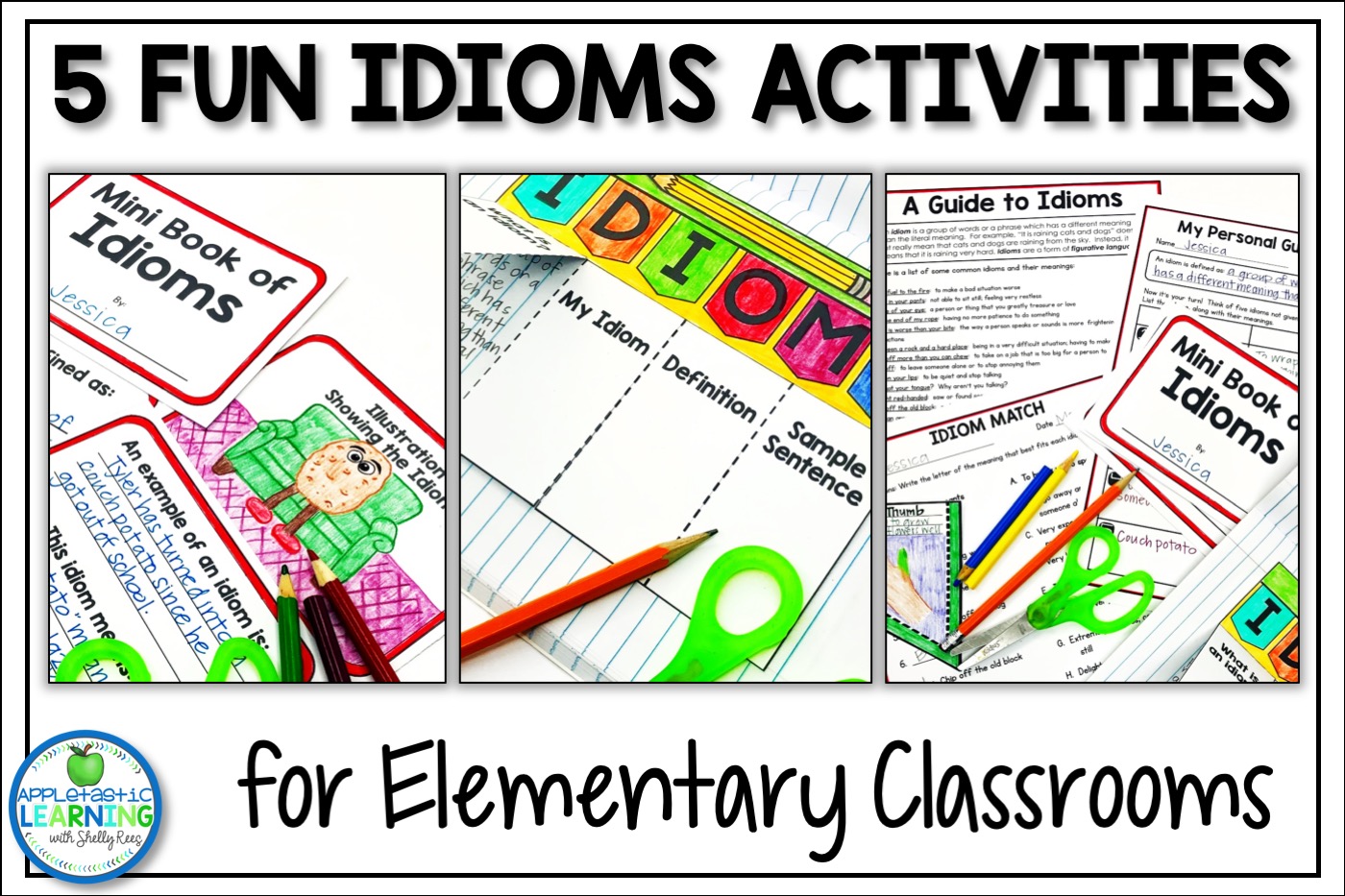

Are you a little wet behind the ears when it comes to teaching idioms? Want a great idiom unit without breaking the bank? Have you been barking up the wrong tree trying to find fun idiom activities? Well, the cat’s out of the bag! Here are 5 fun idiom activities that will make teaching idioms a piece of cake and won’t cost an arm and a leg! And . . . I promise no more idiom filled paragraphs!

Teaching idioms is a lot of fun because the play on words is down right silly sometime! But some students have a difficult time understanding the meaning of idioms or using them correctly. That’s why explicit instruction on idioms is necessary.
Once students know and understand idioms they love using them in their speech and writing. The proper use of idioms can elevate the quality of writing too! They are a great way to add voice and interest to writing too.
Here’s some fun idiom activities that your upper elementary students will love!
A great place to start introducing your students to idioms is by explaining what an idiom is, and then diving into lots and lots of examples. By being exposed to lots of examples, students are able to understand the concept of an idiom. This video is a great introduction to idioms! You might even find yourself playing it over and over again throughout your unit. It’s catchy and engaging and with a little practice your students just might sing along!
This idiom match is a great activity to do as you introduce the topic. Here students can work to identify the meaning of a variety of common idioms. It is fun to let students start by trying to match the meaning of idioms they may have heard before or even used.
You can use this activity like a game and set a time limit for students to match as many idioms as they can. Or allow students to work in pairs or small groups to see if they can complete the entire list.
As you begin learning about idioms, it is also fun to start “Idiom of the Day” in the classroom. Write an idiom on the board and take time to discuss the meaning. Then challenge students to try to use the idiom some time during the day in their speaking or writing. There are sure to be laughs and giggles as students try to answer questions and participate in class discussions while trying to weave the idiom into the conversation!
After students are introduced to the concept of idioms and have had some practice recognizing them and their meanings, challenge students to write down additional idioms that they have heard or used. Students can also look for idioms in books they are reading or listen for them in conversations with family and friends. This activity helps students to see how idioms are used in real life.
If students can’t think of additional idioms on their own, encourage them to use the internet. The goal here is to expose students to more idioms and their meaning. There are lots of great site about the English language that cover idioms. Here a few sites that your students might find helpful:
Once this activity is done, have students choose their favorite idiom to share with the class. In order for the class to learn more idioms you can make it a game where students cannot share an idiom that has already been shared.
What makes idioms so fun and funny is that we tend to visualize the literal meaning of the idioms. This is one activity your students will LOVE and it is a great way to connect the reading skill of visualization to idioms.
Introduce the visualization of idioms with a Pictionary style game. Games are a fantastic way to engage students in learning. As students learn to visualize the literal words, they gain a better understanding of what makes figurative language a useful tool in reading and writing.
Quickly and easily set-up a Pictionary style idiom game. Use the 2 pages of idioms in this packet as your drawing list. Simply cut the list into strips and fold them so students can pick one to draw.
Start by choosing a strip of paper and then drawing literal picture of the idiom on the board. Then let the class guess what the idiom might be. After guessing correctly have a student tell the real meaning of the idiom. The person who answers correctly becomes the next person to draw. After the game, or instead of the game, students can complete their own visualization drawing of an idiom. This idiom drawing activity is always a hit!
You could also turn this worksheet into an interactive display! After students complete the page, have them cover them cover the idiom with a flap of construction paper. Display the drawings on a bulletin board or in the hallway. Viewers can then lift the flap the find out the idiom!
Working with idioms and getting to know their meanings is an important part of learning to use idioms. Students can create an idiom mini-book that will have them making their very own collection of idioms.
In each mini-book students will write the idiom, its meaning and draw an illustration of the idiom’s meaning.
If you have an “Idiom of the Day” this makes a great morning work or bell ringer activity for your students to start class. This draws their attention to the idiom and gives them time to process its meaning before trying to use it in their speech or writing that day.
These books might be mini – but there is lots of learning in each book. The more students work with idioms in isolation, the easier it will be for them to begin using them in their writing and speaking.
I’m not a fan of “teaching to the test” but it is a known fact that when students are able to correctly use figurative language in their essays, their writing scores move up a level. The best way to help this happen naturally is to start by working on idioms in isolation, then teach how figurative language, like idioms can be used as an attention grabbing introduction, to add voice to writing, or close a writing with an extra special ending.
Another fun idiom activity is this idiom banner. Here students will choose an idiom, write its meaning and then draw a picture for the idiom. You can even have students write a sentence using the idiom on the back of the banner or around the edges.
There are a couple different ways to use this activity. Each student can create one pennant on the banner and you can create a class banner. This works really well towards the beginning of the unit as students are learning about idioms and their meanings. If you choose this option it is best for each student to have a different idiom. They can present their idiom to the class and then add it to the banner. Display the banner in the room, as part of an idiom bulletin board or in the hallway.
You can also use this activity as a final review or informal assessment to see what students have learned. Here, students will make their own banner. Four or five pennants make a nice size banner without the activity being overwhelming or taking a lot of time. You can assign students specific idioms, have them randomly draw idioms, or let them choose their own.
Interactive notebooks are a great way for students to create a journal of things they have learned. It gives them a personal learning tool to use when reviewing or need a reminder of a skill or concept. This idiom lift-the-flap activity is the perfect addition to a language arts or grammar interactive notebook.
Students will define idioms, write an idiom and its meaning and then use the idiom in a sentence. You can have students complete this for one idiom or add an extra page or two to create multiple flaps.
Don’t worry if you don’t use interactive notebooks. You can still use this lift-the-flap activity in your classroom. Students can glue the top of this page onto a a piece of construction paper. After cutting the flaps, they can write their answers directly on the construction paper or on the back of the flap.
You can find all of these fun idiom activities in this resource:
If you aren’t quite ready to teach idioms, then add this to your favorite classroom Pinterest board so you can come back when you are ready to add these fun idiom activities to your lesson plans.


Hi, I’m Shelly! Thank you for being here. I love helping third, fourth, and fifth grade teachers with fun and engaging activities that require no to little prep! Let me help you by taking some of the stress and work off your plate.

©2022 Shelly Rees. All Rights Reserved.
